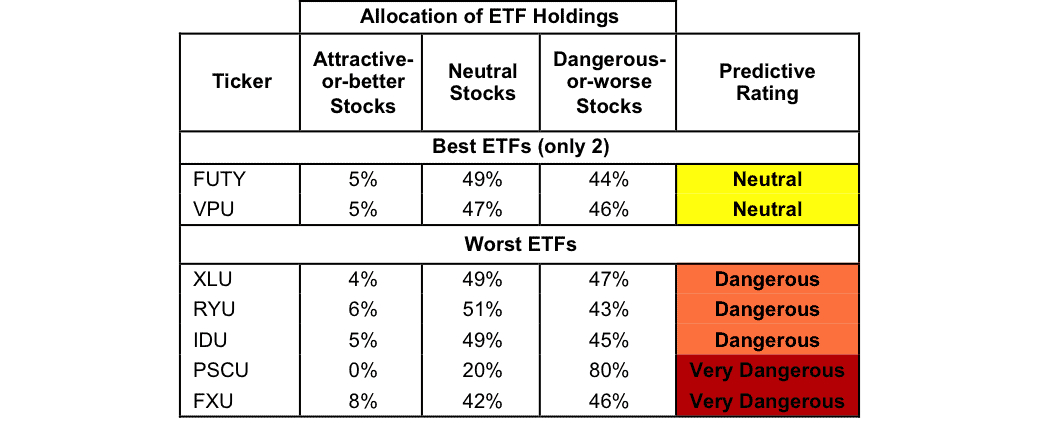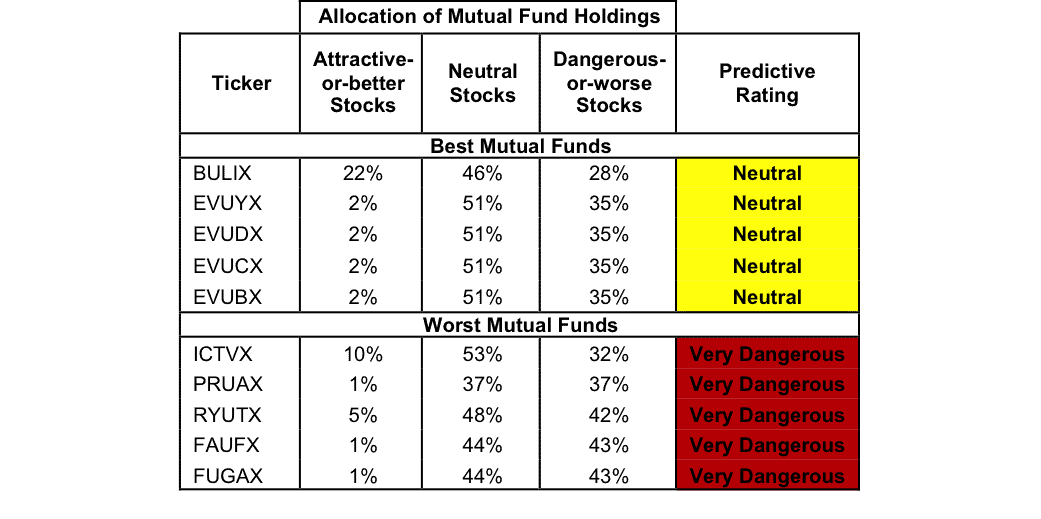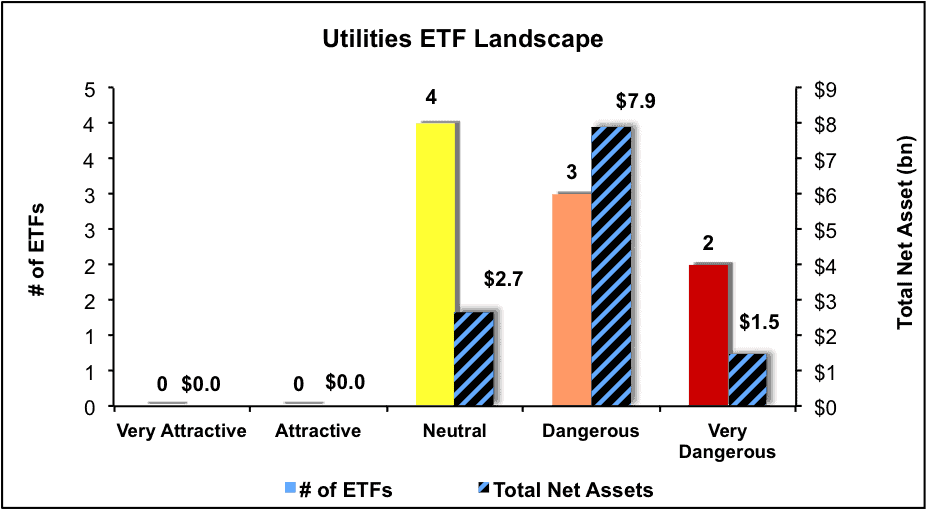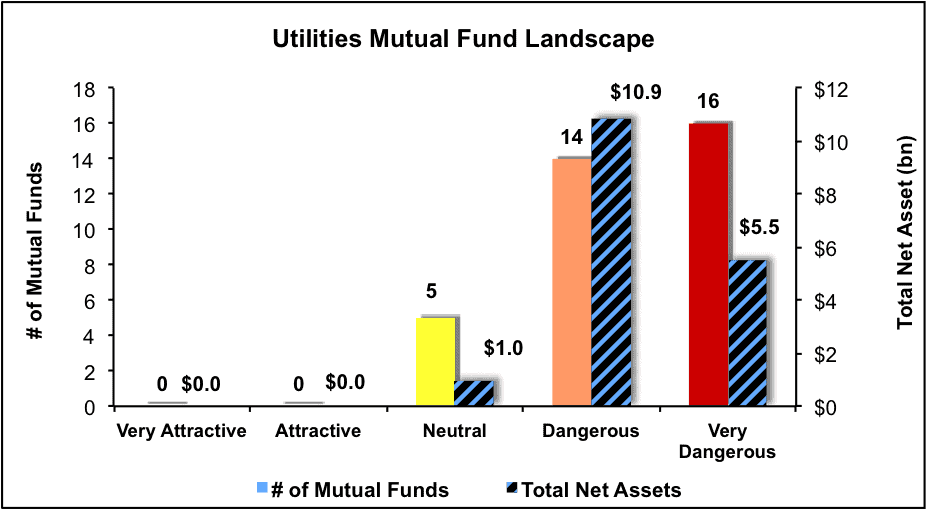The Utilities sector ranks ninth out of the ten sectors as detailed in our 2Q17 Sector Ratings for ETFs and Mutual Funds report. Last quarter, the Utilities sector ranked seventh. It gets our Dangerous rating, which is based on an aggregation of ratings of nine ETFs and 35 mutual funds in the Utilities sector as of April 10, 2017. See a recap of our 1Q17 Sector Ratings here.
Figure 1 ranks from best to worst the seven Utilities ETFs that meet our liquidity standards and Figure 2 shows the five best and worst rated Utilities mutual funds. Not all Utilities sector ETFs and mutual funds are created the same. The number of holdings varies widely (from 16 to 76). This variation creates drastically different investment implications and, therefore, ratings.
Investors should not buy any Utilities ETFs or mutual funds because none get an Attractive-or-better rating. If you must have exposure to this sector, you should buy a basket of Attractive-or-better rated stocks and avoid paying undeserved fund fees. Active management has a long history of not paying off.
Our robo-analyst technology empowers our unique ETF and mutual fund rating methodology, which leverages our rigorous analysis of each fund’s holdings. We think advisors and investors focused on prudent investment decisions should include analysis of fund holdings in their research process for ETFs and mutual funds.
Figure 1: ETFs with the Best & Worst Ratings

* Best ETFs exclude ETFs with TNAs less than $100 million for inadequate liquidity.
Sources: New Constructs, LLC and company filings
PowerShares DWA Utilities Momentum Portfolio (PUI) and Reaves Utilities ETF (UTES) are excluded from Figure 1 because their total net assets (TNA) are below $100 million and do not meet our liquidity minimums.
Figure 2: Mutual Funds with the Best & Worst Ratings – Top 5

* Best mutual funds exclude funds with TNAs less than $100 million for inadequate liquidity.
Sources: New Constructs, LLC and company filings
Fidelity MSCI Utilities Index ETF (FUTY) is the top-rated Utilities ETF and American Century Quantitative Equity Utilities Fund (BULIX) is the top-rated Utilities mutual fund. Both earn a Neutral rating.
First Trust Utilities AlphaDEX Fund (FXU) is the worst rated Utilities ETF and Fidelity Advisor Utilities Fund (FUGAX) is the worst rated Utilities mutual fund. Both earn a Very Dangerous rating.
74 stocks of the 3000+ we cover are classified as Utilities stocks, but due to style drift, Utilities ETFs and mutual funds hold 76 stocks.
The Danger Within
Buying a fund without analyzing its holdings is like buying a stock without analyzing its business and finances. Put another way, research on fund holdings is necessary due diligence because a fund’s performance is only as good as its holdings’ performance. Don’t just take our word for it, see what Barron’s says on this matter.
PERFORMANCE OF HOLDINGs = PERFORMANCE OF FUND
Analyzing each holding within funds is no small task. Our robo-analyst technology enables us to perform this diligence with scale and provide the research needed to fulfill the fiduciary duty of care. More of the biggest names in the financial industry (see At BlackRock, Machines Are Rising Over Managers to Pick Stocks) are now embracing technology to leverage machines in the investment research process. Technology may be the only solution to the dual mandate for research: cut costs and fulfill the fiduciary duty of care. Investors, clients, advisors and analysts deserve the latest in technology to get the diligence required to make prudent investment decisions.
Figures 3 and 4 show the rating landscape of all Utilities ETFs and mutual funds.
Figure 3: Separating the Best ETFs From the Worst ETFs

Sources: New Constructs, LLC and company filings
Figure 4: Separating the Best Mutual Funds From the Worst Mutual Funds

Sources: New Constructs, LLC and company filings
This article originally published on April 10, 2017.
Disclosure: David Trainer and Kyle Guske II receive no compensation to write about any specific stock, sector or theme.
Follow us on Twitter, Facebook, LinkedIn, and StockTwits for real-time alerts on all our research.
Click here to download a PDF of this report.






